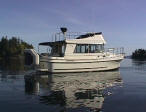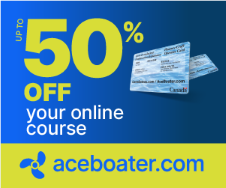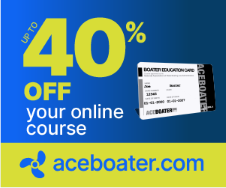Basic Power Boat Standard. 
(DAY SKIPPER - POWER)
Subscribe to our Powerboating email
series
Basic Powerboat Standard
At the completion of the Basic Power boat Standard you should
be able to operate safely in local waters as skipper of a boat over 6 metres and powered by an engine
over 55 kW (75 hp).
PREREQUISITES
None.
ASHORE KNOWLEDGE - Basic Power boat Standard
Section I: Types of Boats
You must be able to:
- Describe the difference between:
a) Displacement hull and planing hull,
b) Outboard, inboard/outboard, and inboard engines.
Section II: Parts of the Boat and
Terminology
You must be able to:
-
Identify and describe the following parts of a boat:
|
Bow |
Beam |
Rudder |
|
Breastlines |
Fenders |
Spring lines |
|
Chine |
Hatch |
Ventilation System |
|
Cleats |
Gunwale |
Deck |
|
Hull |
Keel |
Transom |
|
Head |
Freeboard |
Engine well |
|
Stanchions |
Bow line |
Skeg |
|
Lifelines |
VHF Radio |
Stern line |
-
Define the following terms:
|
Aft |
Making way |
Ahead |
|
Draft |
No way |
Astern |
|
Port |
Underway |
Leeway |
|
Starboard |
Forward |
Wash |
|
Wake |
Section III: The Engine and the Propulsion
Unit
You must be able to:
-
Identify the following parts used in the operation of an outboard,
inboard/outboard, or inboard engine:
a) Common engine parts -
|
Engine cover |
Gear shift lever |
Choke |
|
Starter |
Throttle |
Propeller |
|
Exhaust outlet |
Fuel line connectors |
Fuel line |
|
Fuel level gauge |
Fuel tank |
b) Outboard and inboard/outboard engine parts -
|
Tilt/trim buttons |
Drive unit |
|
Transom mount bolts |
Antiventilation plate |
c) Inboard/outboard and inboard engine parts -
|
Engine bed |
Propeller shaft |
|
Cooling water intake |
Seacock |
d) Inboard engine parts -
|
Rudder post |
Cutlass bearing |
|
Fluid measuring sticks |
Rudder |
|
Stuffing box |
Flange coupling |
- Name and describe the use of the following:
a) Fuel system: fuel tank, fuel line, fuel filter,
b) Ignition system: spark plugs, distributor, ignition wires and coil,
c) Cooling system: water pump, cooling water intake valve and discharge,
thermostat control;
- Describe the importance of selecting the correct propeller and the
significance of pitch and diameter;
-
Describe how to check and maintain the following:
|
Sea water strainer |
Propeller shaft |
|
Steering components |
Spark plugs |
|
Fluid levels |
Alternator belt |
|
Water pump belt |
Electric starter and battery |
|
Power controls and linkages |
Fuel tanks; |
- Describe probable causes and troubleshooting for the following
situations:
a) Engine will not start or is difficult to start,
b) Engine overheats,
c) Engine seems to be running well but then slows down and knocks,
d) Engine spits, coughs or slows,
e) Engine knocks excessively,
f) Engine stops suddenly,
g) Engine is running well but boat is not moving well,
h) Excessive vibration;
- List and describe the required steps to winterize an outboard,
inboard/outboard, and inboard engine.
Section IV: Safety
You must be able to:
- List from memory:
a) the DOT required items for a boat between 6 and 8 metres or between 8 and l2
metres in length as stated in the Safe Boating Guide,
b) the rules for care of PFD’s and Life Jackets,
c) the recommended method of testing for buoyancy in a PFD;
- Describe the importance of the Transport Canada information plate attached to
the hull of power boats;
- For the condition of hypothermia:
a) Define the condition and describe the major areas of heat loss to the
body,
b) Describe treatment for mild and severe hypothermia,
c) List correct actions to be taken by a victim in cold water to increase
survival time;
- Describe the purpose of a safety harness in rough weather
conditions;
- Describe:
a) The common sources of fire and/or explosion on a power boat and methods of
prevention;
b) The danger involved and the precautions to take when recharging
batteries;
- Describe as stated in the Safe Boating Guide:
a) safe refueling procedures
b) the use of each of the different types of flares, their proper storage, and
the method and safety precautions in using them.
- List the main responsibilities of the skipper and crew as listed
below:
Skipper
a) Safety of crew and boat,
b) Briefing on location and operation of lifesaving and other safety equipment
prior to getting underway,
c) Assigning duties,
d) Instruction in the safe use of the boat’s equipment while underway
e) Obligations on observing an accident or boat in distress,
f) Actions to demonstrate respect for other boaters and other’s
property
Crew
a) Obey skipper;
b) Assist skipper
- Describe:
a) The reasons for keeping gear and equipment stowed in assigned places on a boat
and the principles for proper stowage of exta gear and equipment,
b) The frequency of maintenance of a recreational boat and its equipment so that
it is capable of functioning at all times,
c) The minimum items recommended for a waterproof emergency kit,
d) Use and maintenance a marine head and holding tank
system
Section V: Seamanship
You must be able to:
-
Describe one use of each for the following knots and hitches:
|
Bowline |
Reef knot |
Round turn & two half hitches |
|
Figure eight |
Clove Hitch |
Double sheet bend; |
-
Describe the use of the following:
|
Boat hook |
Painter |
Shackles |
|
Grapnel |
Swivel |
Towing Bridle; |
- Describe the danger of your lee shore;
- Describe:
a) The features of a secure anchorage,
b) The holding characteristics of commonly used anchors,
c) Suitable rode makeup and handling,
d) Scope requirements when anchoring for lunch, overnight and in rough
weather;
- List some precautions that should be taken in preparation for heavy
weather;
-
Describe the action to be taken in the following
situations:
|
a) Springing a leak |
f) Capsizing your boat |
|
b) Steering fails |
g) Running aground |
|
c) Dragging anchor |
h) Fouling the propeller |
|
d) Collision with another boat |
i) Engine failure |
|
e) Fire. |
Section VI: Weather
You must be able to:
- List three sources of marine weather
information;
- Describe local weather hazards, the warning expected, and the identification
for both the warning and the hazard. Provide suitable action to be taken to reduce or avoid their
effects;
-
Interpret the marine weather forecast applicable to the area of operation and
apply that information:
a) Determine whether it is safe to go boating,
b) Decide how forecast changes in the weather may influence the day's planned
activities.
c) Identify the wind speeds associated with
|
light winds |
moderate winds |
strong winds |
|
strong wind warning |
gale warning |
storm warning |
Section VII: Navigation
You must be able to:
- Describe the importance of having a compass on board and list the
precautions needed to ensure that the compass receives no undue magnetic influences;
-
Determine the following information from the Canadian Hydrographic chart of
the local area:
|
a) Depth of water |
d) Buoys and navigation aids |
|
b) Types of bottom |
e) Lights and beacons |
|
c) Underwater hazards |
f) Distance scale; |
- State the principles of operating a small boat around large
ships;
- Use the Tide and Current Tables to find:
a) Times and heights of tides at reference ports
b) Direction and rate of current at reference stations.
Section VIII: Boating Regulations and Rules of the
Road
You must be able to:
- Describe the types of boating accidents which need to be reported
and which authority is responsible;
- Apply Collision
Regulations Rules 13 to 21 by means of
diagrams;
- State the name, colour and angle of visibility of lights required
by:
a) a boat under power, under sail, under or giving a tow, and at
anchor;
b) an unpowered boat less than 6 meters
- List six internationally recognized distress signals as stated in the
Safe Boating Guide.
-
Identify and describe the following:
|
Pleasure craft |
Power driven boat |
|
Sailing boat |
Recommended gross load capacity |
|
Capacity plate |
Recommended safe limit of engine power |
-
Demonstrate knowledge of regulations applying to boaters:
a) Identify the minimum required publications for operating a 10 meter
pleasure boat in unfamiliar waters,
b) Describe the guidelines for licensing and how a license number must be
marked on a boat,
c) Identify the principal acts / legislation that a pleasure craft operator
should be knowledgeable about, and the areas covered by each including:
|
Canada Shipping Act |
Small Vessel Regulations, |
|
Boating Restriction Regulations |
Contraventions Act |
|
Collision Regulations |
The Criminal Code of Canada. |
d) Describe the process and guidelines for licensing your boat and
how a license number must be marked on a boat,
- Identify:
a) Four considerations in determining the safe speed to operate a
boat,
b) The actions and precautions to be taken in reduced visibility,
c) Your responsibilities when operating in a commercial traffic lane;
d) The proper courtesies for operating in restricted passages and in
harbours,
- Describe the installation, use, capabilities and limitations of a radar
reflector;
Section IX: Complementary Water Sport
Guidelines
You must be able to:
- Describe the correct techniques for the following:
a) Driving while towing a water skier
b) Returning a towline to a fallen skier
c) Picking up a fallen skier;
d) Observing the skier
e) Water and dock starts
-
Describe the following water ski hand signals:
|
a) Speed up or down |
d) Turn |
|
b) Speed OK |
e) Stop |
|
c) Head back |
f) "I'm OK" after a fall; |
- Identify the diving signal flags and appropriate boat operation when in sight
of such flags.
Section X: Trailering a Boat
You must be able to:
- List the main criteria for selecting a
trailer;
- Describe the importance of load distribution between the trailer and the
vehicle's hitch;
- Explain the fundamental skills needed to back a trailer attached to a
vehicle;
- List the main steps required when launching and retrieving a boat with a
trailer;
- Describe how and why to pack the wheel bearings on a
trailer.
AFLOAT SKILLS Basic Powerboat Standard continued on the following page
|









